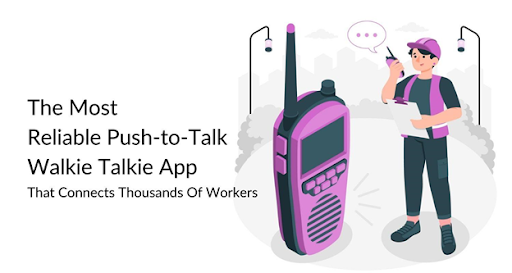Do you remember long-range two-way radios used for a very long time to connect workers on the field with those in the office?
Right! They’re commonly called Walkie Talkies.
Due to the enormous leaps in technology, long-range walkie-talkies are no longer productive and outdated. From real-time chats to scheduled messages, connecting employees and workers have become more intuitive.
When new technologies are emerging, most business services need to WORK SMARTER, NOT HARDER, to save time, increase productivity, and increase efficiency. Several enhanced approaches have been devised to replace older two-way radios, mostly walkie-talkies, to meet the needs of the modern business landscape.
The inefficiency of technologies (Walkie-talkie apps /hardware for team collaboration) to perform up to standards of today’s enterprise value decreases the level of communication.
Recommended: Manage your inventory with a powerful inventory management software!
Contents
Does It Sound Like You? If So, I’d Suggest You Look Here
The following are a few disappointments that drive your workers apart and hinder your team from successfully achieving their goals.
- When priorities are high, the system is bulky and clunky
- To repair and replace something costs an arm and a leg
- There is a lack of updates and stagnation in the infrastructure
- Worker’s reach is inadequate (no scalability)
- Communicating effectively becomes more difficult
- Customers are so poorly served
- Business today requires something more futuristic
- Revenue can’t be boosted by it
Say goodbye to walkie-talkies and hello to push-to-talk Solution.
Bring Push-To-Talk to the modern world
This technology provides instant voice messaging using digital data engineering, a codec, and half-duplex technology.
In push-to-talk technology, messages are passed from one app to another over webRTC. This feature can be integrated into any business-class push-to-talk app or standalone app by contacting an enterprise-level push-to-talk service provider like NuovoTeam.
There are basically two types;
- One-to-one (1 to 1)
- One-to-many
In one-to-many, there are many groups, communities, channels, and broadcasters involved.
Why Push-To-Talk Instead Of Walkie-Talkies Can Propel Your Service Communication
Push-to-talk devices can be a lifesaver in industries that deploy field employees; a point to note is that some industries require Push-to-talk devices to function efficiently. There are many industries where Push-to-talk devices can be used, with their usage expanding to an array of necessary requirements; limitations pertaining to a distance no longer pose a problem due to devices such as the Peak Push-to-talk device working in any area where cellular coverage is available. Therefore, industries such as construction, event management, energy, and similar can easily deploy workers equipped with the necessary devices to remain in contact.
Industry: Transportation
- Reduce the risk of heavy drivers during distractions.
- Whenever and wherever they are, you can reach the crew right away.
- Maintaining the safety of drivers.
- Streamline & improve performance and productivity.
- Providing drivers with real-time directions to their destinations.
Field Service & Industries
- Make better decisions with real-time updates.
- Deliver safety information to workers without interfering with their work.
- Enhances communication in harsh and noisy environments.
- Off-field productivity can be improved by optimizing resources.
Construction Industries
- Construction workers now have better access to information.
- Despite a noisy construction environment, it provides crisp and clear audio. Connecting workers in real-time save a lot of time.
- The user is more productive and makes better decisions.
The Benefits Of Implementing Push-To-Talk Software Into Your Business
As mentioned previously, Push-to-talk systems have continuously evolved to provide flexible features to their users, though its basic purpose remains the same, that is, to allow individuals to communicate vocally with one another and/or to groups. Push-to-talk uses 4G devices, called “long term evolution network radios”, so even if cell networks turn down their 3G bands, users of a Push-to-talk will be covered for years to come. It is, of course, unnecessary to state that this development is only one of the benefits of utilizing Push-to-talk technology, which offers numerous other benefits. In areas where cellular coverage is limited, push-to-talk radio systems allow companies to keep in touch with workers who are in close proximity or in remote areas. Push-to-talk radio devices can withstand a multitude of environmental conditions where cellphones might not be feasible or effective. Additionally, Push to Talk radios provide the emergency services with a reliable channel that can be utilized to stay in touch with the relevant authorities and other emergency personnel.
These are few benefits of implementing PTT technology.
- Using a secure Push-to-talk application, all costs are reduced, and an average of $17,250 is saved over three years.
- It is possible to connect with multiple workers at the same time.
- The management of calls during emergencies and crises should be improved.
Closing lines
Besides these sectors and industries, walkie-talkie apps have improved a variety of industries including hospitality, education, logistics, NGOs, and education. Organizations should rely on the Push-to-talk solutions in the market to replace old walkie-talkies & improve their efficiency. Choose an enterprise-grade PTT solution if you struggle to take your employees’ communication to the next level over smartphones or apps.

